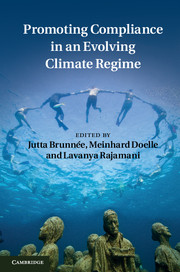81 results
8 - State Consent in the Evolving Climate Regime
- from Part II - Objects and Types of Consent
-
-
- Book:
- Consenting to International Law
- Published online:
- 23 November 2023
- Print publication:
- 07 December 2023, pp 180-203
-
- Chapter
- Export citation
Multilateralism in Crisis
-
- Journal:
- Proceedings of the ASIL Annual Meeting / Volume 112 / 2018
- Published online by Cambridge University Press:
- 22 March 2019, pp. 335-339
- Print publication:
- 2018
-
- Article
- Export citation
SELF-DEFENCE AGAINST NON-STATE ACTORS: ARE POWERFUL STATES WILLING BUT UNABLE TO CHANGE INTERNATIONAL LAW?
-
- Journal:
- International & Comparative Law Quarterly / Volume 67 / Issue 2 / April 2018
- Published online by Cambridge University Press:
- 06 November 2017, pp. 263-286
- Print publication:
- April 2018
-
- Article
-
- You have access
- HTML
- Export citation
6 - The Rule of Law in an Agnostic World
-
-
- Book:
- The Law of International Lawyers
- Published online:
- 25 May 2017
- Print publication:
- 30 March 2017, pp 137-166
-
- Chapter
- Export citation
2 - Transparency and International Environmental Institutions
- from Part I - International Environmental Law
-
-
- Book:
- Transparency in International Law
- Published online:
- 05 December 2013
- Print publication:
- 07 November 2013, pp 23-48
-
- Chapter
- Export citation
Contributors
-
-
- Book:
- Transparency in International Law
- Published online:
- 05 December 2013
- Print publication:
- 07 November 2013, pp x-xii
-
- Chapter
- Export citation
5 - Constructivism and International Law
-
-
- Book:
- Interdisciplinary Perspectives on International Law and International Relations
- Published online:
- 05 January 2013
- Print publication:
- 24 December 2012, pp 119-145
-
- Chapter
- Export citation
Index
-
- Book:
- Promoting Compliance in an Evolving Climate Regime
- Published online:
- 05 January 2012
- Print publication:
- 08 December 2011, pp 479-495
-
- Chapter
- Export citation
Abbreviations
-
- Book:
- Promoting Compliance in an Evolving Climate Regime
- Published online:
- 05 January 2012
- Print publication:
- 08 December 2011, pp xiii-xvi
-
- Chapter
- Export citation
Part I - Context
-
- Book:
- Promoting Compliance in an Evolving Climate Regime
- Published online:
- 05 January 2012
- Print publication:
- 08 December 2011, pp 15-16
-
- Chapter
- Export citation
Frontmatter
-
- Book:
- Promoting Compliance in an Evolving Climate Regime
- Published online:
- 05 January 2012
- Print publication:
- 08 December 2011, pp i-iv
-
- Chapter
- Export citation
Bibliography
-
- Book:
- Promoting Compliance in an Evolving Climate Regime
- Published online:
- 05 January 2012
- Print publication:
- 08 December 2011, pp 459-478
-
- Chapter
- Export citation
Contents
-
- Book:
- Promoting Compliance in an Evolving Climate Regime
- Published online:
- 05 January 2012
- Print publication:
- 08 December 2011, pp v-vii
-
- Chapter
- Export citation
Part IV - A look forward
-
- Book:
- Promoting Compliance in an Evolving Climate Regime
- Published online:
- 05 January 2012
- Print publication:
- 08 December 2011, pp 435-436
-
- Chapter
- Export citation
Preface
-
-
- Book:
- Promoting Compliance in an Evolving Climate Regime
- Published online:
- 05 January 2012
- Print publication:
- 08 December 2011, pp xi-xii
-
- Chapter
- Export citation
Part II - The Kyoto compliance system: Features and experience
-
- Book:
- Promoting Compliance in an Evolving Climate Regime
- Published online:
- 05 January 2012
- Print publication:
- 08 December 2011, pp 75-76
-
- Chapter
- Export citation
Contributors
-
- Book:
- Promoting Compliance in an Evolving Climate Regime
- Published online:
- 05 January 2012
- Print publication:
- 08 December 2011, pp viii-x
-
- Chapter
- Export citation
Part III - Compliance and the climate regime: Issues, options, and challenges
-
- Book:
- Promoting Compliance in an Evolving Climate Regime
- Published online:
- 05 January 2012
- Print publication:
- 08 December 2011, pp 147-148
-
- Chapter
- Export citation
Conclusion
-
-
- Book:
- Promoting Compliance in an Evolving Climate Regime
- Published online:
- 05 January 2012
- Print publication:
- 08 December 2011, pp 437-458
-
- Chapter
- Export citation

Promoting Compliance in an Evolving Climate Regime
-
- Published online:
- 05 January 2012
- Print publication:
- 08 December 2011

